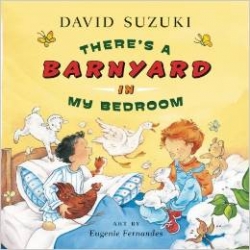Search for Resources
Description
Imagination and some everyday objects send Megan and Jamie on three incredible journeys of discovery as they learn how nature provides us with everything we need. A rainy day hike teaches the pair about food and household products that originate as plants or animals. A day at the beach includes a lesson about air as well as planting a garden that sends the duo back in time to explore how soil is formed. Students will be inspired by this story as they realize how Earth supports all life and the nature that surrounds us.
General Assessment
Recommendation of how and where to use it
This book provides an ideal introduction to any exploration of how humans meet their needs. A lunchbox investigation could have students researching which plants and animals their food comes from and learning more about local and organic foods.
The topic of air could be used to introduce students to the importance of plant respiration in providing oxygen. A class could also learn about the role of large forests as the "lungs" of the planet and develop a school tree planting project.
A soil study could have students collecting a soil sample and describing each of its living and non-living components. A local organic farmer could also assist the class with setting up a school compost project. As a stewardship activity students could be responsible for collecting organic materials and maintaining the composter. Finished compost could be sold locally to support other school "green" initiatives like purchasing recycled paper.
Relevant Curriculum Units
The following tool will allow you to explore the relevant curriculum matches for this resource. To start, select a province listed below.
- Step 1Select a province
- Alberta
- Step 2Select a grade level
- Kindergarten
- Step 3Select a subject
- Science
- Step 4Relevant matches
- Earth Systems: Understandings of the living world, Earth, and space are deepened through investigating natural systems and their interactions.
- Grade 1
- Step 3Select a subject
- Science
- Step 4Relevant matches
- Living Systems: Understandings of the living world, Earth, and space are deepened through investigating natural systems and their interactions.
- Grade 2
- Step 3Select a subject
- Science
- Step 4Relevant matches
- Living Systems: Understandings of the living world, Earth, and space are deepened through investigating natural systems and their interactions
- Grade 3
- Step 3Select a subject
- Science
- Step 4Relevant matches
- Living Systems: Understandings of the living world, Earth, and space are deepened through investigating natural systems and their interactions
- British Columbia
- Step 2Select a grade level
- Grade 1
- Step 3Select a subject
- Science
- Step 4Relevant matches
- Science 1: Living things have features and behaviours that help them survive in their environment
- Grade 2
- Step 3Select a subject
- Science
- Step 4Relevant matches
- Science 2: Living things have life cycles adapted to their environment
- Grade 3
- Step 3Select a subject
- Science
- Step 4Relevant matches
- Science 3: Living things are diverse, can be grouped, and interact in their ecosystems
- Manitoba
- New Brunswick
- Step 2Select a grade level
- Kindergarten
- Step 3Select a subject
- Science
- Step 4Relevant matches
- Explore Your World: Well-Being
- Grade 1
- Step 3Select a subject
- Science
- Step 4Relevant matches
- Explore Your World: Well-Being
- Grade 2
- Step 3Select a subject
- Science
- Step 4Relevant matches
- Explore Your World: Well-Being
- Grade 3
- Step 3Select a subject
- Science
- Step 4Relevant matches
- Our Local Environment : :Scientific Literacy
- Newfoundland & Labrador
- Northwest Territories
- Nova Scotia
- Step 2Select a grade level
- Kindergarten
- Step 3Select a subject
- Science
- Step 4Relevant matches
- Primary Science: Living Things
- Grade 1
- Step 3Select a subject
- Science
- Step 4Relevant matches
- Science 1: Needs of Living Things
- Grade 3
- Step 3Select a subject
- Science
- Step 4Relevant matches
- Science 3: Plants
- Science 3: Soil
- Nunavut
- Prince Edward Island
- Saskatchewan
- Step 2Select a grade level
- Kindergarten
- Step 3Select a subject
- Science
- Step 4Relevant matches
- Units & Outcomes
- Grade 1
- Step 3Select a subject
- Science
- Step 4Relevant matches
- Needs & Characteristics of Living Things
- Grade 3
- Step 3Select a subject
- Science
- Step 4Relevant matches
- Exploring Soils
- Plant Growth and Changes
- Yukon Territory
- Step 2Select a grade level
- Grade 1
- Step 3Select a subject
- Science
- Step 4Relevant matches
- Science 1: Living things have features and behaviours that help them survive in their environment
- Grade 2
- Step 3Select a subject
- Science
- Step 4Relevant matches
- Science 2: Living things have life cycles adapted to their environment
- Grade 3
- Step 3Select a subject
- Science
- Step 4Relevant matches
- Science 3: Living things are diverse, can be grouped, and interact in their ecosystems
Themes Addressed
Air, Atmosphere & Climate (1)
- Weather
Ecosystems (1)
- Appreciating the Natural World
Food & Agriculture (1)
- Local Food
Land Use & Natural Resources (1)
- Rocks and Minerals
Water (1)
- Water Cycle

